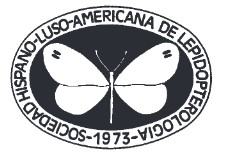Rhopalocera en un paisaje modificado: El campus universitario de Mizoram, Aizawl, Mizoram, India (Lepidoptera: Papilionoidea)
DOI:
https://doi.org/10.57065/shilap.904Palabras clave:
Lepidoptera, Papilionoidea, estudio, biodiversidad, conservación, hábitat, IndiaResumen
Se realizó un estudio de la diversidad de Rhopalocera en el campus de la Universidad de Mizoram (MZU) en zonas seleccionadas con diferentes tipos de hábitat. Se adoptó el método de muestreo Pollard walks y se establecieron 16 transectos lineales permanentes seleccionados al azar en tres lugares diferentes. La longitud de los transectos estudiados era de 500 m y la anchura era una región cubierta por la observación visual a ambos lados desde el punto de observación a lo largo de la longitud. El estudio se llevó a cabo de septiembre a noviembre de 2016 y de febrero a mayo de 2017. Se registró un total de 3.618 individuos de 78 especies de estos insectos pertenecientes a seis familias. El mayor número de especies registradas pertenecía a la familia Nymphalidae, mientras que la familia Riodinidae está representada por una sola especie. También se registraron tres especies raras: Parthenos sylvia (Cramer, 1775), Elymnias patna (Westwood, 1851) y Tanaecia lepidea (Butler, 1868). Otro aspecto importante de este estudio es el registro de Euploea midamus (Linnaeus, 1758), Castalius rosimon (Fabricius, 1775), Jamides allectus (Grose-Smith, 1894), Euploea mulciber (Cramer, [1777]) y Polytremis discreta (Elwes & Edwards, 1897), que están clasificadas en diferentes listas de conservación de la Ley de la Fauna India (Protección) Acto 2022. Nymphalidae es la especie más diversa (H = 3,295) y dominante (D = 22,727), mientras que la uniformidad es mayor para la familia Pieridae (E = 0,973) y la diversidad, dominancia y uniformidad (H = 1,818, D = 5,646, E = 0,826) es menor para la familia Lycaenidae. Este estudio pone de manifiesto que los hábitats modificados son también importantes depósitos de biodiversidad a los que hay que prestar atención para su conservación.
Descargas
Estadísticas globales ℹ️
|
727
Visualizaciones
|
239
Descargas
|
|
966
Total
|
|
Citas
Barua, K. K. (2007). Diversity and habitat selection of Papilionidae in a protected forest reserve in Assam, Northeast India. [Ph. D. Thesis] Georg-August University.
Bora, A., & Meitei, L. R. (2014). Diversity of butterflies (Order: Lepidoptera) in Assam University Campus and its vicinity, Cachar district, Assam, India. Journal of Biodiversity and Environmental Science, 5(3), 328-339
Courtney, S. P (1986). The ecology of Pieridae butterfly: Dynamics and Interaction. Advances in Ecology Research, 15, 51-115. https://doi.org/10.1016/S0065-2504(08)60120-8 DOI: https://doi.org/10.1016/S0065-2504(08)60120-8
De Vries, P. J. (1987). The Butterflies of Costa Rica and Their Natural History: Papilionidae, Pieridae, Nymphalidae (Vol. 1). Princeton University Press.
De Vries, P. J. (1997). The Butterflies of Costa Rica and Their Natural History: Riodinidae (Vol. 2). Princeton University Press.
Evans, W. H. (1932). The identification of Indian Butterflies. Bombay Natural History Society Publication.
Eswaran, R., & Pramod, P. (2005). Structure of butterfly community of Anaikatty hills, Western Ghats. Zoo’s Print, 20, 1939-1942. https://doi.org/10.11609/JoTT.ZPJ.1330.1939-42 DOI: https://doi.org/10.11609/JoTT.ZPJ.1330.1939-42
Fahrig, L. (2003). Effects of habitat fragmentation on biodiversity. Annual Review of Ecology, Evolution, and Systematics, 34, 487-515. https://doi.org/10.1146/annurev.ecolsys.34.011802.132419 DOI: https://doi.org/10.1146/annurev.ecolsys.34.011802.132419
Fernández, I. C., & Simonetti, J. A. (2013). Small mammal assemblages in fragmented shrub lands of urban areas of Central Chile. Urban Ecosystems, 16, 377-387. https://doi.org/10.1007/s11252-012-0272-1 DOI: https://doi.org/10.1007/s11252-012-0272-1
Ghosh, S. K., & Majumder, M. (2007). Fauna of Mizoram (Insecta: Lepidoptera). State Fauna Series, 14, 399-412.
Gogoi, M. J. (2012). Butterflies (Lepidoptera) of Dubang valley, Mishmi hills, Arunachal Pradesh, India. Journal of Threatened Taxa, 4(12), 3137-3160. https://doi.org/10.11609/JoTT.o2975.3137-60 DOI: https://doi.org/10.11609/JoTT.o2975.3137-60
Gupta, I. J. ( 2007). Fauna of Mizoram (Insecta: Lepidoptera). State Fauna Series, 14, 427-453.
Gupta, I. J., & Maulik, D. R. (2007). Fauna of Mizoram (Insetca: Lepidoptera). State Fauna Series, 14, 413-426.
Guthula,V. B., Shroyriya, S., Nigam, P., Goyal, S. P., Mohan, D., & Habib, B. (2022). Biodiversity significance of small habitat patches: More than half of Indian birds’ species are in academic campuses. Landscape and Urban Planning, 228, 104552-104565. https://doi.org/10.1016/j.landurbplan.2022.104552 DOI: https://doi.org/10.1016/j.landurbplan.2022.104552
Haddad, N. M., Brudvig, L. A., Clobert, J., Davies, K. F., Gonzalez, A., Holt, R. D., & Townshend, J. R. (2015). Habitat fragmentation and its lasting impact on Earth’s ecosystems. Science Advances 1(2), 1-10. https://doi.org/10.1126/sciadv.1500052 DOI: https://doi.org/10.1126/sciadv.1500052
Hossain, M. A., & Ahmad, A. (2017). Livelihood status of hill dwellers in Bandarban, Bangladesh. International Journal of Business, Management and Social Research, 3(1), 154-161. https://doi.org/10.18801/ijbmsr.030117.18 DOI: https://doi.org/10.18801/ijbmsr.030117.18
Kehimkar, I. (2008). The Book of Indian Butterflies. Bombay Natural History Society Publication.
Khanal, B., Chalise, M. K., & Solanki, G. S. (2013). Threatened butterflies of Central Nepal. Journal of Threatened Taxa, 5(11), 4612-4615. https://doi.org/10.11609/JoTT.o2825.4612-5 DOI: https://doi.org/10.11609/JoTT.o2825.4612-5
Kocher, S. D., & Williams, E. H. (2000). The diversity and abundance of North American butterflies vary with habitat disturbance and geography. Journal of Biogeography, 27, 785-794. https://doi.org/10.1046/j.1365-2699.2000.00454.x DOI: https://doi.org/10.1046/j.1365-2699.2000.00454.x
Kunte, K. J. (1997). Seasonal patterns in butterfly abundance and species diversity in four tropical habitats in northern Western Ghats. Journal of Biosciences, 22, 593-603. https://doi.org/10.1007/BF02703397 DOI: https://doi.org/10.1007/BF02703397
Krishnakumar, N., Kumaraguru, A., Thiyagesan, K., & Asokan S. (2007). Diversity of papilionid butterflies in the Indira Gandhi Wildlife Sanctuary, Western Ghats, Southern India. Tiger Paper, 35, 1-8.
Lalchhuanawma (2008). Ecological studies on plant diversity and productivity of herbaceous species in Mizoram university campus at Tanhril, Aizawl, Mizoram (N. E. India). [Ph. D. Thesis]. Mizoram University.
Lalthafamkima, K. (2017). Study on diversity of spiders inside Mizoram University campus, Aizawl, Mizoram. [M. Sc.]. Mizoram University.
Liu, J., Yu, M., Tomlinson, K., & Slik, J. W. F. (2017). Patterns and drivers of plant biodiversity in Chinese university campuses. Landscape and Urban Planning, 164, 64-70. https://doi.org/10.1016/j.landurbplan.2017.04.008 DOI: https://doi.org/10.1016/j.landurbplan.2017.04.008
Liu, J., Zhao, Y., Feng, G., Slik, F., & Zhang, J. (2021). University campuses as valuable resources for urban biodiversity and conservation. Urban Forestry and Urban Greening, 64, 127255. https://doi.org/10.1016/j.ufug.2021.127255 DOI: https://doi.org/10.1016/j.ufug.2021.127255
Mazumdar, K., Soud, R. & Gupta, A. (2011). Mammalian diversity of degraded forest habitats around Assam University Campus, Cachar, Assam, India, with notes on conservation status. Our Nature 9, 119-127. https://doi.org/10.3126/on.v9i1.5742 DOI: https://doi.org/10.3126/on.v9i1.5742
Nerlekar, A. N., Warudkar, A. M., Gowande, G. G., Salve, S. S., Raut, A. S., Patankar, R., & Nalavade, S. B. (2016). A review of the faunal diversity of the Fergusson College campus, Pune, India. Zoo’s Prints, 29(10), 4-25.
Opdam, P., Verboom, J. & Pouwels, R. (2003). Landscape cohesion: an index for the conservation potential of landscapes for biodiversity. Landscape Ecology, 18, 113-126. https://doi.org/10.1023/A:1024429715253 DOI: https://doi.org/10.1023/A:1024429715253
Pielou, E. C. (1969). An Introduction to Mathematical Ecology. John Wiley, New York.
Pereira, H. M., Navarro, L. M., & Martins, I. S. (2012). Global biodiversity change: The bad, the good, and the unknown. Annual Review of Environment and Resources, 37(1), 25-50. https://doi.org/10.1146/annurevenviron-042911-093511 DOI: https://doi.org/10.1146/annurev-environ-042911-093511
Pollard, E., & Yates, T. J. (1993). Monitoring Butterflies for Ecology and Conservation: The British Butterfly Monitoring Scheme. Chapman and Hall.
Saikia, M. K. (2014). Diversity of tropical butterflies in urban altered forest at Gauhati University campus, Jalukbari, Assam. Journal of Global Bioresources, 3(2), 452-463.
Sailo, L., Solanki, G. S., & Lalhruaizela, C. (2019). Avian diversity in Mizoram University Campus, Aizawl, Mizoram. Science and Technology Journal, 7(1), 54-68. https://doi.org/10.22232/stj.2019.07.01.08 DOI: https://doi.org/10.22232/stj.2019.07.01.08
Shannon, C. E. (1948). A mathematical theory of communication. Bell System Technical Journal, 27(4), 379-423. https://doi.org/10.1002/j.1538-7305.1948.tb00917.x DOI: https://doi.org/10.1002/j.1538-7305.1948.tb01338.x
Simpson, E. H. (1949). Measurement of diversity. Nature, 163, 688. https://doi.org/10.1038/163688a0 DOI: https://doi.org/10.1038/163688a0
Singh, A. P. (2010). Butterfly diversity in tropical moist deciduous sal forests of Ankua Reserve Forest, Koina Range, Saranda Division, West Singhbhumi District, Jharkhand, India. Journal of Threatened Taxa, 2(9), 1130-1139. https://doi.org/10.11609/JoTT.o2274.1130-9 DOI: https://doi.org/10.11609/JoTT.o2274.1130-9
Swinhoe, C. (1905-1910). Lepidoptera Indica (Part VII). Reeve & Co. Ltd.
Talbot, G. (1947). The Fauna of British India, including Ceylon and Burma: Butterflies (Vol. II). Taylor and Francis.
Teegalapalli, K., Gopi, G. V., & Samal, P. K. (2009). Forest recovery following shifting cultivation: an overview of existing research. Tropical Conservation Science, 2(4), 374-387. https://doi.org/10.1177/194008290900200401 DOI: https://doi.org/10.1177/194008290900200401
The Wildlife (Protection) Act 1972. Natraj Publishers.
Vallejo, B., Aloya, A., Ong, P., Tamino, A., & Villasper, J. (2008). Spatial patterns of bird diversity and abundance in an urban tropical landscape: The University of the Philippines Diliman campus. Science Diliman, 20(1), 1-10. https://doi.org/10.54645/IPYZ58175 DOI: https://doi.org/10.54645/IPYZ58175
Vanlalhlimpuia (2012). Diversity of herpetofauna in Mizoram University campus, Aizawl, Mizoram. [M. Sc.]. Mizoram University.
Varshney, R. K., & Smetacek, P. (eds). (2015). A Synopsis Catalogue of the Butterflies of India. Bhimtal and Indinov Publishing.
Voon, A. M., Nasradhi, K. A., Rahman, M. A., & Azlan, J. M. (2014). Bird diversity, density, and foraging activities in a university campus landscape in Sarawak. Borneo Journal of Resources Science and Technology, 4(2), 9-20. https://doi.org/10.33736/bjrst.232.2014 DOI: https://doi.org/10.33736/bjrst.232.2014
Wintle, B. A., Kujala, H., Whitehead, A., Cameron, A., Veloz, S., Kukkala, A., & Bekessy, S. A. (2018). Global synthesis of conservation studies reveals the importance of small habitat patches for biodiversity. Proceedings of the National Academy of Sciences of the United States of America, 116(3), 909-914. https://doi.org/10.1073/pnas.1813051115 DOI: https://doi.org/10.1073/pnas.1813051115
Yadav, P. K. (2013). Slash-and-burn agriculture in north-east India. Expert Opinion in Environment and Biology, 2(1), 1-4. https://doi. org/10.4172/2325-9655.1000102 DOI: https://doi.org/10.4172/2325-9655.1000102
Zothansangi, C., Ruati, V. L., Senthil, K. S. N., Gurusubramanian, G., & Lalremsanga, H. T. (2018). A preliminary survey of butterfly diversity in Dampa Tiger Reserve of Mizoram, Northeast India. Conference: Issues and Trends of Wildlife Conservation in Northeast India 2014. Mizoram University. Zoological Survey of India (2007). Fauna of Mizoram. State Fauna Series, 14, 692.
Descargas
Publicado
Cómo citar
Número
Sección
Licencia

Esta obra está bajo una licencia internacional Creative Commons Atribución 4.0.
El autor retiene sus derechos de marca y patente sobre cualquier proceso o procedimiento dentro del artículo.
El autor retiene el derecho de compartir, distribuir, ejecutar y comunicar públicamente el artículo publicado en SHILAP Revista de lepidopterología, con reconocimiento inicial de su publicación en SHILAP Revista de lepidopterología.
El autor retiene el derecho para hacer una posterior publicación de su trabajo, de utilizar el artículo a publicarlo en un libro, siempre que indique su publicación inicial en SHILAP Revista de lepidopterología.
Cada envío a SHILAP Revista de lepidopterología debe ir acompañado de una aceptación de los derechos de autor y del reconocimiento de autoría. Al aceptarlos, los autores conservan los derechos de autor de su trabajo y aceptan que el artículo, si es aceptado para su publicación por SHILAP Revista de lepidopterología, tendrá una licencia de uso y distribución “Reconocimiento 4.0 Internacional de Creative Commons” (CC BY 4.0), que permite a terceros compartir y adaptar el contenido para cualquier propósito dando el crédito apropiado al trabajo original.
Puede consultar desde aquí la versión informativa y el texto legal de la licencia. La indicación de la licencia CC BY 4.0 debe indicarse expresamente de esta manera cuando sea necesario.
A partir de 2022, el contenido de la versión impresa y digital se encuentra bajo una licencia de uso y distribución “Reconocimiento 4.0 Internacional de Creative Commons” (CC BY 4.0), que permite a terceros compartir y adaptar el contenido para cualquier propósito dando el crédito apropiado al trabajo original.
El contenido anterior de la revista se publicó bajo una licencia tradicional de derechos de autor; sin embargo, el archivo está disponible para acceso gratuito.
Al usar el contenido de SHILAP Revista de lepidopterología publicado antes del año 2022, incluidas figuras, tablas o cualquier otro material en formato impreso o electrónico pertenecen a los autores de los artículos, los autores deben obtener el permiso del titular de los derechos de autor. Las responsabilidades legales, financieras y penales a este respecto pertenecen al autor(es).
En aplicación del Principio de Prioridad del Código Internacional de Nomenclatura Zoologica, no se autoriza el depósito en repositorios, páginas web personales o similares de cualquier otra versión distinta a la publicada por el editor.




























